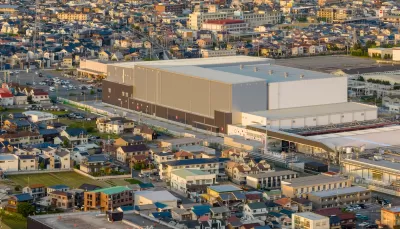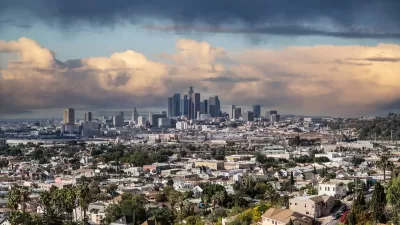Environmental justice is an important issue, but does not justify playing with the numbers. But that's exactly what I found in a new study of the impacts of warehouses in New Jersey done by the Environmental Defense Foundation.

In recent years, the environmental justice movement has become an important part of the larger movement for social justice. It has shone a light on the environmental damage done to many low-income, Black and Latino communities, and on the ways that top-down decisions have disproportionately concentrated facilities such as pollution-generating factories, incinerators, and hazardous waste dumps, in those communities. But does the manifest justice of the cause justify playing with the numbers to find harms where they may or may not actually exist?
This question is prompted by a recent study released by the Environmental Defense Fund on warehouses in New Jersey, entitled New Jersey Warehouse Boom: Tracing the growth of warehouses and their impacts. The proliferation of warehouses has become a major bone of contention in New Jersey. Small, large, and supersized, they seem to be going up everywhere these days, from urban redevelopment areas to one-time cornfields. This is unsurprising since New Jersey is a densely populated, highly industrialized, state, and increasingly a global transportation hub.
Predictably, the study drew media attention, and on July 4th the front page headline of the Star-Ledger (for out-of-staters, our only truly statewide newspaper) read “NJ warehouse boom parceled out unequally, study finds; health threats have outsize presence in communities of color, say environmentalists.” The study, done by the Environmental Defense Fund, does not mince words, stating up front that “due to racist legacies of redlining and other discriminatory policies, new and existing distribution facilities and the roads that serve them are disproportionately located near communities of color and low-income communities.”
Being familiar with environmental injustice issues, I was prepared to believe that on general principles; but as a researcher who takes data seriously, I wanted to look under the hood at the data the EDF used to reach its conclusion. This is where it gets interesting. The study states that “EDF identified 3,034 truck-attracting facilities, which include all warehouses exceeding 50,000 square feet in environmental justice communities or 100,000 square feet in non-environmental justice communities.” Although the report does not explicitly define environmental justice communities, it appears to be the same as “overburdened communities” as defined in the New Jersey Environmental Justice Law (N.J. Statutes 13:1D-157), that is, areas with disproportionate shares of low income populations, people of color, or people of limited English proficiency.
The study justifies the double standard by arguing that “By including smaller facilities in [environmental justice] communities, this analysis recognizes the disproportionately high concentration of polluting facilities and resulting health burdens that these communities experience.”
That language should convince no one. Yes, low-income communities and communities of color experience higher concentrations of polluting facilities in general, but that’s not what the report is about. It’s about warehouses, not about incinerators or abandoned industrial sites. And while there’s a good case that for regulatory purposes it makes sense to set a more stringent standard in environmental justice communities (as a bill introduced in the New Jersey legislature would do), that’s a very different matter than claiming to do a research study.
Readers who understand statistics will already know where I’m heading. If you increase the number of cases in some areas but not in others, you increase the likelihood of impacts in those areas where you’ve increased the number of cases — in this case the environmental justice communities. Let me offer a perhaps crude illustration.
Let’s say an anti-immigration group wants to show that areas with large numbers of immigrants have more crime than areas with fewer immigrants. So they define “crimes” in low immigrant areas as the number of murders, but “crimes” in high immigrant areas as the number of murders and aggravated assaults. Eureka! Their report “shows” that crime is much higher in the high immigrant areas. I would like to think that any thoughtful reader would spot the problem, and such a report would be quickly discredited.
But that is, of course, exactly what the EDF has done in their warehouse study. Now, I have no idea how many warehouses fall into the 50,000 to 100,000 square foot category. The study doesn’t say: it could be a handful, or it could be a thousand or more. If the number is small, the effect on the results is likely de minimis, and the findings would probably hold up if they compared apples to apples, instead of pomegranates. But, one wonders, if that were the case, why would they commit such an egregious violation of statistical good faith?
I have no doubt that many low-income communities and communities of color are negatively affected by warehouses and the truck traffic associated with them. I also suspect, since warehouses in urban areas are often located adjacent to homes and apartments — unlike suburban warehouses which tend to be tucked into well-buffered industrial parks — warehouse for warehouse, their impacts may be significantly greater. That's a real issue. But the study provides no clue to any of this, nor suggests ways the impacts could be mitigated without those communities losing whatever job benefits they gain from having warehouses and ports nearby.
There’s a larger point to this story. All of us concerned with social justice are painfully aware of the extent of injustice and inequity that exists in the United States and are constantly trying to bring it to the attention of decision-makers and the wider public. And following the argument that the end justifies the means, the temptation to tweak the numbers or cherry-pick the facts to dramatize the injustice is constantly present, although rarely indulged to the extent of the EDF study. But whether in small or large ways, we have to resist that temptation. Not only does it raise serious ethical issues, but to be caught doing so can discredit the entire movement.
The end does not justify the means.

Planetizen Federal Action Tracker
A weekly monitor of how Trump’s orders and actions are impacting planners and planning in America.

Restaurant Patios Were a Pandemic Win — Why Were They so Hard to Keep?
Social distancing requirements and changes in travel patterns prompted cities to pilot new uses for street and sidewalk space. Then it got complicated.

Map: Where Senate Republicans Want to Sell Your Public Lands
For public land advocates, the Senate Republicans’ proposal to sell millions of acres of public land in the West is “the biggest fight of their careers.”

Maui's Vacation Rental Debate Turns Ugly
Verbal attacks, misinformation campaigns and fistfights plague a high-stakes debate to convert thousands of vacation rentals into long-term housing.

San Francisco Suspends Traffic Calming Amidst Record Deaths
Citing “a challenging fiscal landscape,” the city will cease the program on the heels of 42 traffic deaths, including 24 pedestrians.

California Homeless Arrests, Citations Spike After Ruling
An investigation reveals that anti-homeless actions increased up to 500% after Grants Pass v. Johnson — even in cities claiming no policy change.
Urban Design for Planners 1: Software Tools
This six-course series explores essential urban design concepts using open source software and equips planners with the tools they need to participate fully in the urban design process.
Planning for Universal Design
Learn the tools for implementing Universal Design in planning regulations.
Heyer Gruel & Associates PA
JM Goldson LLC
Custer County Colorado
City of Camden Redevelopment Agency
City of Astoria
Transportation Research & Education Center (TREC) at Portland State University
Camden Redevelopment Agency
City of Claremont
Municipality of Princeton (NJ)






























